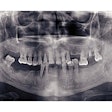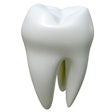Researchers from Louisiana State University (LSU) Health Sciences Center have reported the first use of a surgical robot guided by a miniature salivary endoscope to remove a 20-mm salivary stone and repair the salivary duct of a 31-year-old patient (Laryngoscope, November 16, 2010).
Giant stones have traditionally required complete removal of the salivary gland.
Building upon their success with the combination of salivary endoscopic guidance with surgery, Rohan Walvekar, MD, an assistant professor of otolaryngology head and neck surgery at LSU, and his team have advanced the procedure by adding robotics, they noted in a press release. The technique not only saves the salivary gland, it also reduces blood loss, scarring, and hospital stay, they said.
"Robot-assisted removal of stones is a technical advance in the management of salivary stones within the submandibular gland," Dr. Walvekar said in the release. "We have found it to be helpful in performing careful dissections of the floor of mouth, preserving vital structures in this region -- mainly the lingual nerve, submandibular gland, and salivary duct. The use of the salivary endoscopes in addition to the robotic unit makes the procedure even safer and target-oriented."
Salivary endoscopes revolutionized the management of salivary stones by allowing experienced surgeons to remove the stone while preserving the gland. The endoscopes improve surgical view, exposure, and magnification of the surgical field through a two-dimensional view. The robotic unit produces a high-definition, 3D image. The magnification and dexterity provided by the robot in the confined space of the oral cavity allow excellent identification of vital structures and also the placement of sutures.
"The robot-assisted stone removal was first devised and performed in the department of otolaryngology head and neck surgery at LSU Health Sciences Center New Orleans," Dr. Walvekar said. "With these newer advances, mainly salivary duct endoscopy and robotic surgery, we can offer minimally invasive, gland-preserving, same-day, surgical procedures that represent a tremendous advance over the traditional gland removing surgery via neck incision that is recommended for this clinical condition."
Copyright © 2010 DrBicuspid.com


















